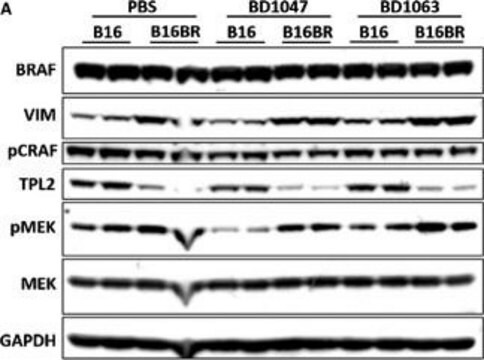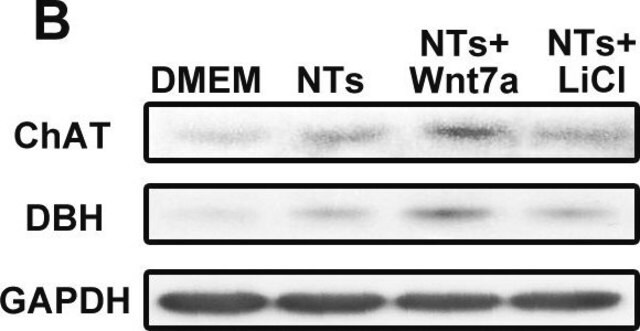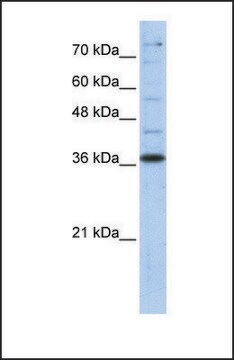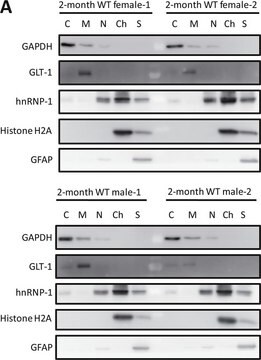SAB1405848
Anti-GAPDH antibody produced in mouse
purified immunoglobulin, buffered aqueous solution
Synonym(s):
G3PD, GAPD, MGC88685
Sign Into View Organizational & Contract Pricing
All Photos(3)
About This Item
UNSPSC Code:
12352203
NACRES:
NA.41
Recommended Products
biological source
mouse
Quality Level
conjugate
unconjugated
antibody form
purified immunoglobulin
antibody product type
primary antibodies
clone
polyclonal
form
buffered aqueous solution
mol wt
antigen ~36.1 kDa
species reactivity
human
technique(s)
indirect immunofluorescence: suitable
western blot: 1 μg/mL
NCBI accession no.
UniProt accession no.
shipped in
dry ice
storage temp.
−20°C
target post-translational modification
unmodified
Gene Information
human ... GAPDH(2597)
General description
The product of this gene catalyzes an important energy-yielding step in carbohydrate metabolism, the reversible oxidative phosphorylation of glyceraldehyde-3-phosphate in the presence of inorganic phosphate and nicotinamide adenine dinucleotide (NAD). The enzyme exists as a tetramer of identical chains. Many pseudogenes similar to this locus are present in the human genome. (provided by RefSeq)
Immunogen
GAPDH (NP_002037.2, 1 a.a. ~ 335 a.a) full-length human protein.
Sequence
MGKVKVGVNGFGRIGRLVTRAAFNSGKVDIVAINDPFIDLNYMVYMFQYDSTHGKFHGTVKAENGKLVINGNPITIFQERDPSKIKWGDAGAEYVVESTGVFTTMEKAGAHLQGGAKRVIISAPSADAPMFVMGVNHEKYDNSLKIISNASCTTNCLAPLAKVIHDNFGIVEGLMTTVHAITATQKTVDGPSGKLWRDGRGALQNIIPASTGAAKAVGKVIPELNGKLTGMAFRVPTANVSVVDLTCRLEKPAKYDDIKKVVKQASEGPLKGILGYTEHQVVSSDFNSDTHSSTFDAGAGIALNDHFVKLISWYDNEFGYSNRVVDLMAHMASKE
Sequence
MGKVKVGVNGFGRIGRLVTRAAFNSGKVDIVAINDPFIDLNYMVYMFQYDSTHGKFHGTVKAENGKLVINGNPITIFQERDPSKIKWGDAGAEYVVESTGVFTTMEKAGAHLQGGAKRVIISAPSADAPMFVMGVNHEKYDNSLKIISNASCTTNCLAPLAKVIHDNFGIVEGLMTTVHAITATQKTVDGPSGKLWRDGRGALQNIIPASTGAAKAVGKVIPELNGKLTGMAFRVPTANVSVVDLTCRLEKPAKYDDIKKVVKQASEGPLKGILGYTEHQVVSSDFNSDTHSSTFDAGAGIALNDHFVKLISWYDNEFGYSNRVVDLMAHMASKE
Application
Anti-GAPDH antibody is suitable for use in indirect immunofluorescence and western blot.
Physical form
Solution in phosphate buffered saline, pH 7.4
Disclaimer
Unless otherwise stated in our catalog or other company documentation accompanying the product(s), our products are intended for research use only and are not to be used for any other purpose, which includes but is not limited to, unauthorized commercial uses, in vitro diagnostic uses, ex vivo or in vivo therapeutic uses or any type of consumption or application to humans or animals.
Not finding the right product?
Try our Product Selector Tool.
recommended
Product No.
Description
Pricing
Storage Class
10 - Combustible liquids
wgk_germany
WGK 1
flash_point_f
Not applicable
flash_point_c
Not applicable
Choose from one of the most recent versions:
Already Own This Product?
Find documentation for the products that you have recently purchased in the Document Library.
Customers Also Viewed
Jie Li et al.
Journal of molecular and cellular cardiology, 102, 53-60 (2016-12-04)
Diabetic cardiomyopathy is a major risk factor in diabetic patients but its pathogenesis remains poorly understood. The ubiquitin-proteasome system (UPS) facilitates protein quality control by degrading unnecessary and damaged proteins in eukaryotic cells, and dysfunction of UPS is implicated in
Dong Liu et al.
Journal of molecular cell biology, 8(2), 144-156 (2015-12-30)
Endoplasmic reticulum (ER) stress is involved in ischemic preconditioning that protects various organs from ischemia/reperfusion (I/R) injury. We established an in vivo ER stress preconditioning model in which tunicamycin was injected into rats before hepatic I/R. The hepatic I/R injury
Hong-Pei Yu et al.
Scientific reports, 5, 9853-9853 (2015-05-01)
Previous study revealed that the protective effect of TIGAR in cell survival is mediated through the increase in PPP (pentose phosphate pathway) flux. However, it remains unexplored if TIGAR plays an important role in DNA damage and repair. This study
Hailin Han et al.
Oncology letters, 15(2), 2073-2078 (2018-02-13)
Receptor for activated C kinase 1 (RACK1) is associated with certain aspects of cancer biology and signaling pathways, but its function in pancreatic ductal adenocarcinoma (PDAC) remains unknown. In the present study, 157 patients with PDAC were enrolled. RACK1 mRNA
Qi Xie et al.
Nature neuroscience, 18(4), 501-510 (2015-03-03)
Brain tumor initiating cells (BTICs) co-opt the neuronal high affinity glucose transporter, GLUT3, to withstand metabolic stress. We investigated another mechanism critical to brain metabolism, mitochondrial morphology, in BTICs. BTIC mitochondria were fragmented relative to non-BTIC tumor cell mitochondria, suggesting
Our team of scientists has experience in all areas of research including Life Science, Material Science, Chemical Synthesis, Chromatography, Analytical and many others.
Contact Technical Service









